Etruscan Archaic/Early High Classical Art and Architecture
Italy - Tuscan: Very famous for their metalwork. Lots of cultural influence from Greeks (ex. Temples dedicated to their gods).
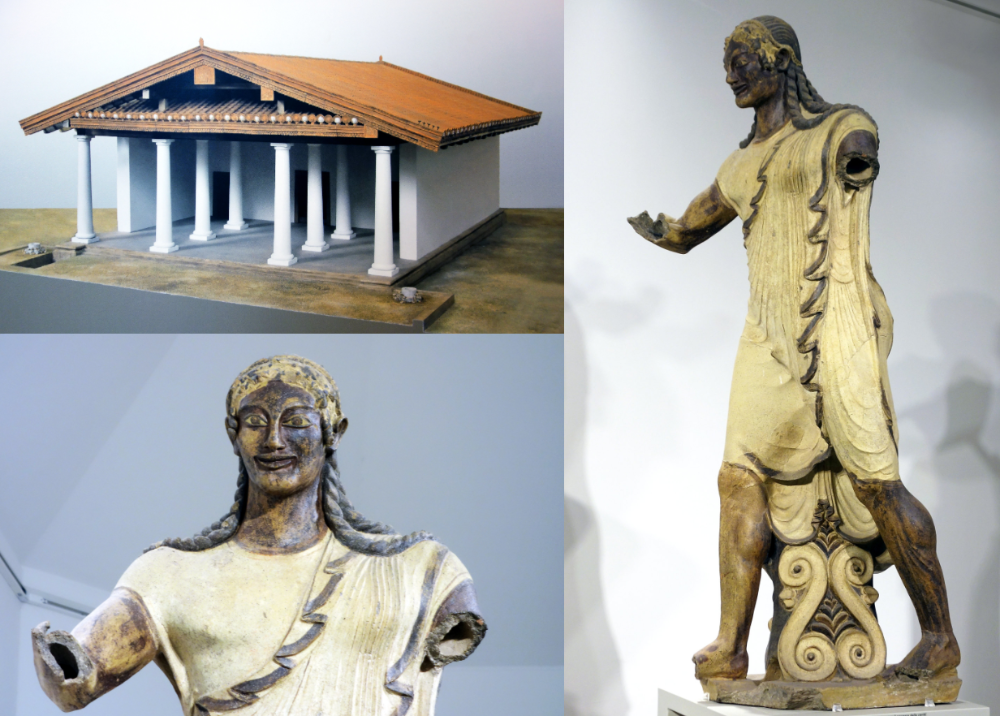
Etruscan Temple model with figure of Apulu from roof. 6th Century BCE. Veii, Italy. Wood, stone foundation and terra cotta sculpture and roof tiles. Etruscan Archaic.
Temples are more square, not made of stone, and figures lined the rooftop unlike Greek temples. Painted like Greek sculptures. Archaic smile, movement and liveliness in the sculpture. Stylized depiction of the Gods: very broad shoulders, drapery. Story: Hercules is sent by someone to steal Artemis' magic deer. Apollo (Apulu), Artemis' brother confronts Hercules and asks him to give back the deer, Hercules won't until his employer sees the deer.
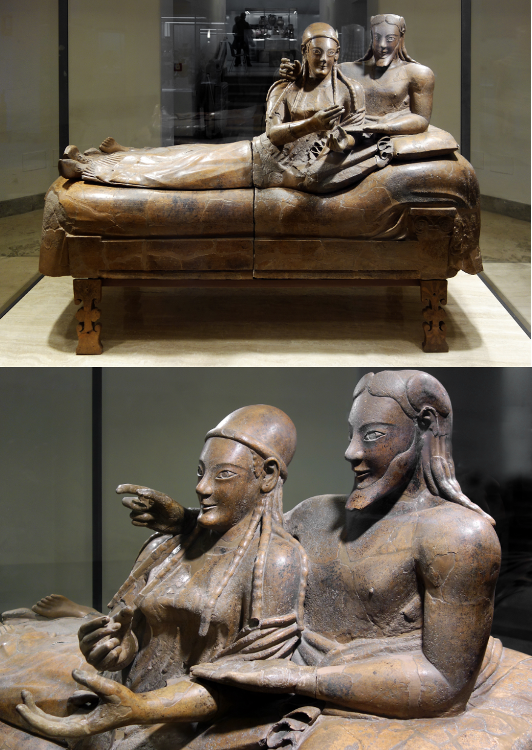
Sarcophagus with reclining spouses, 520 BCE, terra cotta. Cerveteri, Italy. Late Archaic Etruscan.
Etruscan tomb held this Sarcophagus. Tomb carved out of Tufa, soft volcanic stone found all over Italy. The dead hang out and drink for all of eternity in these tombs. Very wealthy class created these tombs. The sarcophagus itself is a lid that can be lifted off. The figures are very lively, not stiff. Intimately embraced, not like Greek culture at this time. Cremated ash in the Sarcophagus. Etruscan women were much more present and involved in the economy than Greek women.
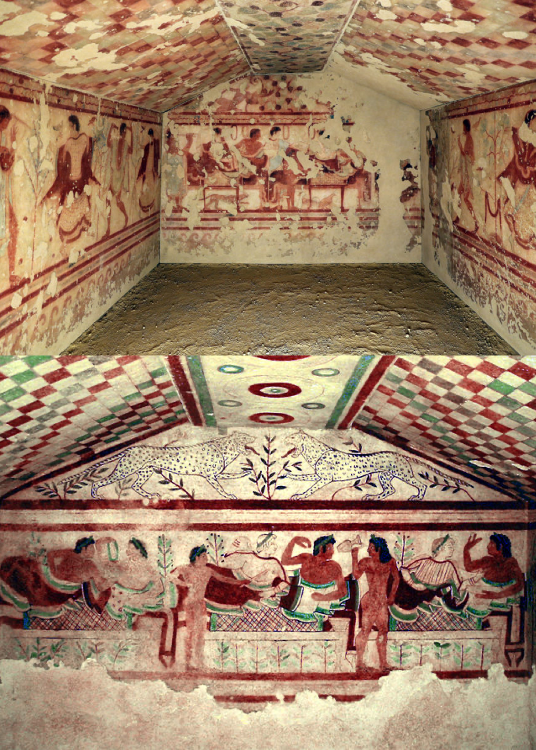
Sarcophagus with reclining spouses, 520 BCE, terra cotta. Cerveteri, Italy. Late Archaic/Early Classical Etruscan.
Fresco: wall covered in plaster, have to paint well and fast while the plaster is wet. Creates a long lasting painting. Depicts a funerary banquet with both men and women. Light skin is a distinguishing feature between men and women back then. Bodies are stylized: in composite figures. Ceiling is meant to represent the tent in which the funerary banquet happens.
Greek Late Archaic/High Classical Architecture
The Greek city state, Athens runs the government. Control the citizens, you can sell yourself into debt. An aristocrat starts creating reforms in 590 BCE, makes laws that make it unable to sell yourself into debt, slavery. Tries to create 4 classes of all male property owners. That goes on for 10 years, the first time there is anything like a democracy in Greece. Another reform later in 509 BCE, he divides Athens geographically into 12 tribes. Form the Delian League because they've gotten into a war with the Persians (Persepolis), from 490-450 BCE. Persians invaded Athens and destroyed their acropolis, for about half a century the acropolis remained destroyed. Athenians swore they would never rebuild Acropolis as a reminder of what the Persians did to them and their Gods. Then under the leadership of Pericles in the 5th century, the Athenians vow to restore the acropolis to build something for the Gods. Delos - neutral, small city state as a place for their treasury, then move it to Athens. Take that money and rebuild Acropolis.

The Athenian Agora. Athens Greece, 6th Century BCE to 2nd Century CE. Greek Late Archaic.
The most important public space in Athens in the 5th century BCE. All the sacred spots were located up high above, the Agora located at the base was the place of public discourse. Athenians were experimenting with democracy. Offices held in rotation not election. Had to be male, Athenian, and both parents had to have been Athenian. Meritocracy: equality before the law. The Agora started out as a place of market and shopping but then gradually during the Archaic and classical periods became a place of government with administrative buildings, and also some sacred spots as well.
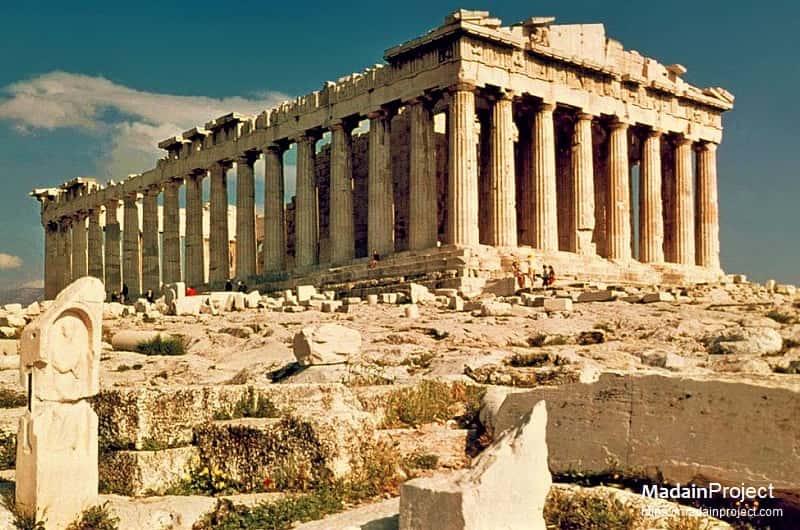
The Acropolis of Athens. Rebuilt from 447 BCE to 410 BCE. Marble and other building materials. Greek High Classical.
Persians destroyed the Acropolis, Athenians vowed to never rebuild it as a reminder of what the Persians had done to them and their Gods. Pericles convinced them to rebuild it, he took money from the treasury on Delos island to rebuild Acropolis as an offering to Athena. Was very, very expensive. y = 2x +1 was the formula for canonical proportions, eight columns. Temple was intended to be a canon and have ideal visual appearance. All the columns are an optical allusion, not the same distance away from each other but they appear that way.
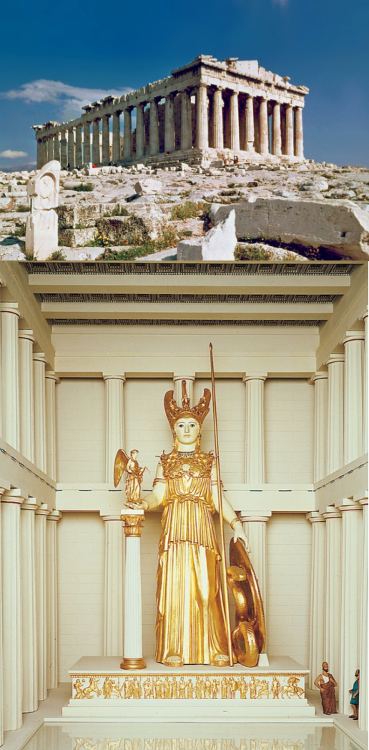
The Parthenon (Temple of Athena Parthenos). Iktinos and Kallicrates. 447-431 BCE. Marble, ivory and other materials. Athens. Greek High Classical.
Huge marble temple dedicated to the Goddess Athena. A doric temple with ionic elements. Very high up, overlooking the city and the sea. The birthplace of democracy. Served a sacred and political purpose. The sculpted decoration of the Parthenon included 92 metopes showing scenes of mythical battle. Human Lapiths vs. Centaurs. The birth of Athena. Two Gods vying to be the Patron of the city, Poseidon and Athena. Both Gods gave the people a gift, Poseidon offers salt water, Athena offers an olive tree, representing the land of prosperity and peace. All these sculptures in the walls reinforce that the Greeks were superior to the barbarians, Greek propaganda.
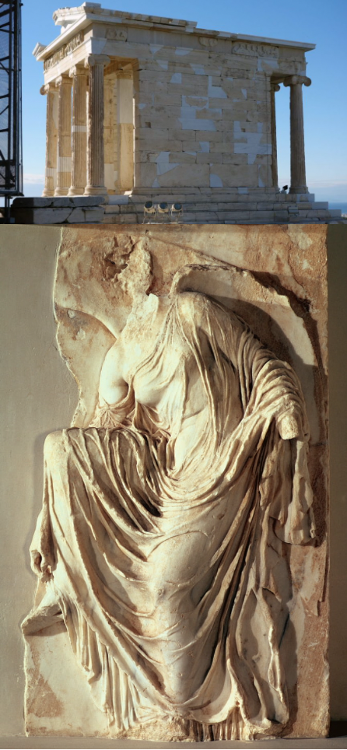
The Temple of Athena Nike, 427-424 BCE. Marble. Greek High Classical.
An ionic temple. The temple was placed at the edge of a cliff. The spot, highly vulnerable to attack but also well placed for defense, was appropriate for the worship of the Goddess of victory. Previously thought that this Nike didn't have wings so that the Athenians could keep her there. But recently discovered that she probably did have wings. She is taking off her sandals to enter the temple. Her drapery is the wet drapery style. It falls over the body and look almost translucent, like its dipped in water. It's almost as if the fabric is meant to cover the body, but to reveal it. Very natural pose, sense of balance, especially if there were wings.
Greek Late Archaic/High Classical Sculpture
" "
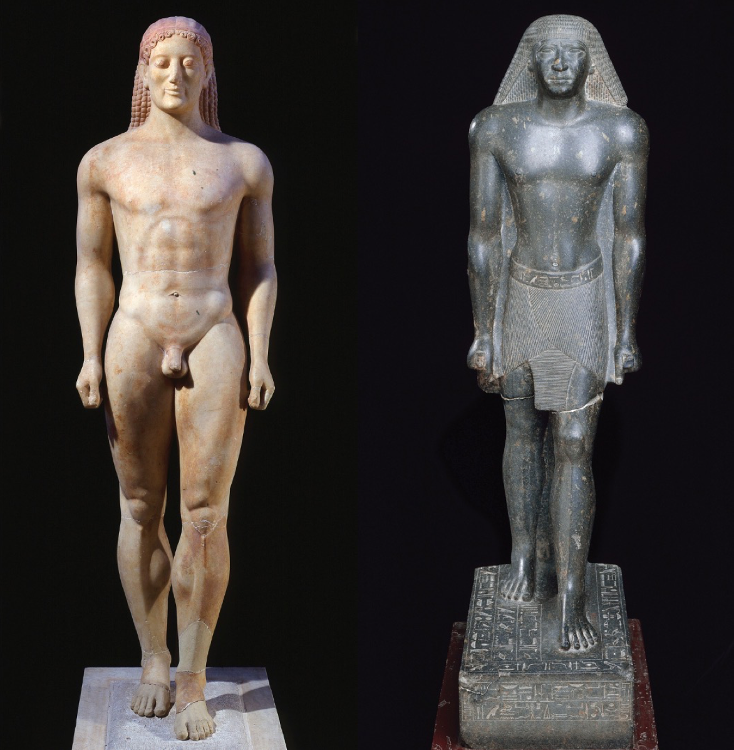
“Kroisos,” Kouros from Anavysos, c. 530 BCE. Marble and paint. Greek Late Archaic.
Found buried near a graveyard, meant to be a Grave marker. The figure has lots of Egyptian influence: same stiffness, left foot forward, fisted hands. Greek figure has much larger waist with more defined God-like muscles, he is in the nude, he wears the archaic smile. Greek figure is made of marble, Egyptian is made of granite. Gaps in the Greek statue, not in the Egyptian, Greek one breaks. Greek figures feet and ankles are much more realistic, but not as stable.
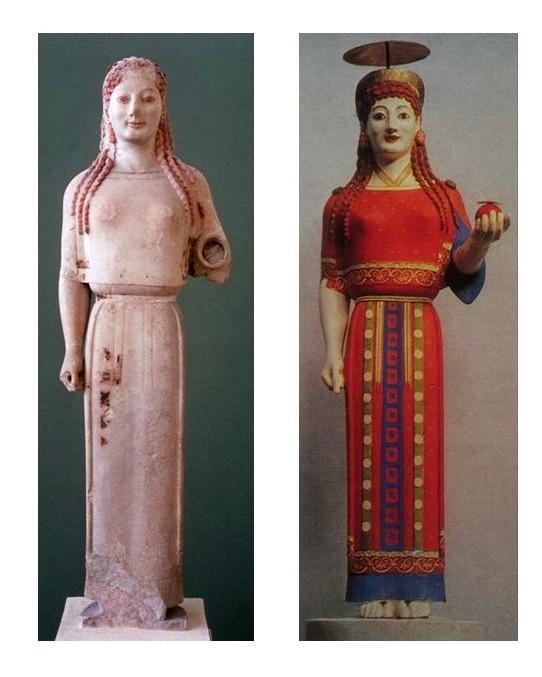
“Peplos Kore” found on the Acropolis, Athens. Marble and paint. 530 BCE. Greek Late Archaic.
Kore: female figure who is clothed. Found on the Acropolis. New research suggests she might be a cult statue and not a votive statue. What she's wearing is very unusual and is what most Goddess' usually wear. She could be Artemis or Athena. Might have been holding a bow and arrow (Artemis). Most likely wore a diadem because of the holes in her head, this would show her divinity. Archaic smile and stiff figure.
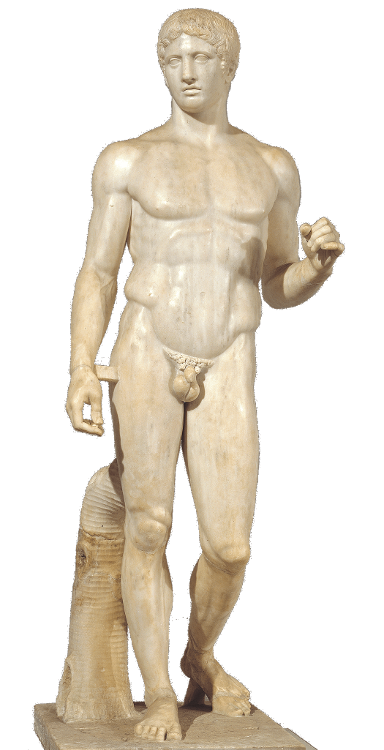
Doryphoros (Spearbearer). Polykleitos. 450-440 BCE. Bronze original; example of curriculum is a Roman marble copy. Greek High Classical.
Polykleitos sculpted this as a 'canon', a showpiece meant to demonstrate the correct proportions and pose to students. Symmetria: ideal proportions for everything in the universe. We don't have the original. Polykleitos watched people and took a bunch of hot men home, measured them, and came up with averages. Contrapposto: balance in an asymmetrical figure. A well developed body controlled by a rational mind was the ideal, seen as the rise of realism and Greek political power and the Athenian empire defeating the Persian empire. As society moved further into the sciences and mathematics, it led to a greater emphasis on realism.
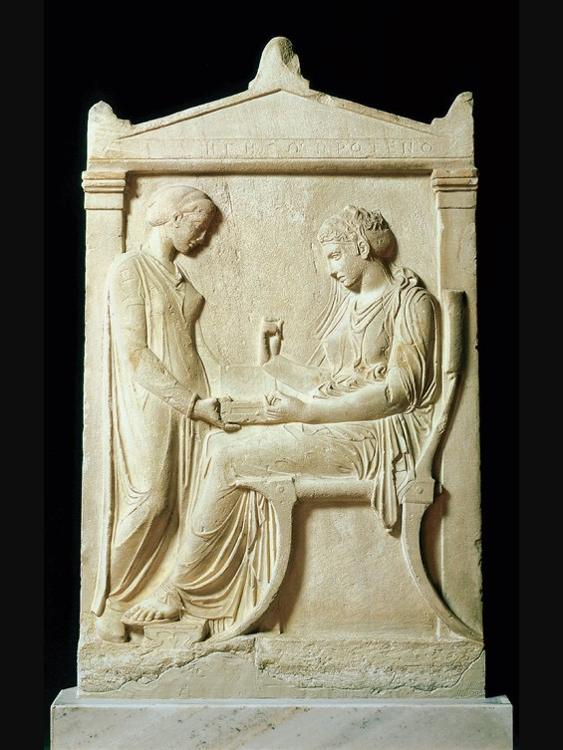
Grave stele of Heges, Kallimachos c. 400 BCE. Marble and paint. Greek Late High Classical.
Placed by a grave. This funeral commemoration became really popular because in 411 BCE, Athens loses a civil war with Sparta, Athenian democracy is on hiatus. The figure sitting is the diseased, depicted in a hieratic scale, she is way taller and larger and her drapery is much fancier than the other woman who is likely a servant. Private sculpture begins to reemerge instead of being commissioned by the state. Women weren't citizens of Athens, only really defined by what men they involve with. She is portrayed in a domestic setting. Very wealthy: hairstyle, elaborate clothing, jewelry, ideal body.
Hellenistic Greek Sculpture
Alexander the Great conquered all of Persian Empire, Egypt. Pergamum is a city state. Ptolemaic Kingdom. Greek culture is seen as cultural superiority. The aristocrats are very wealthy, are able to build more lavishly and unusually. Very innovative and dramatic new art, much more dramatic and unbalanced poses with emotion in the faces, depiction of figures who aren't ideal.
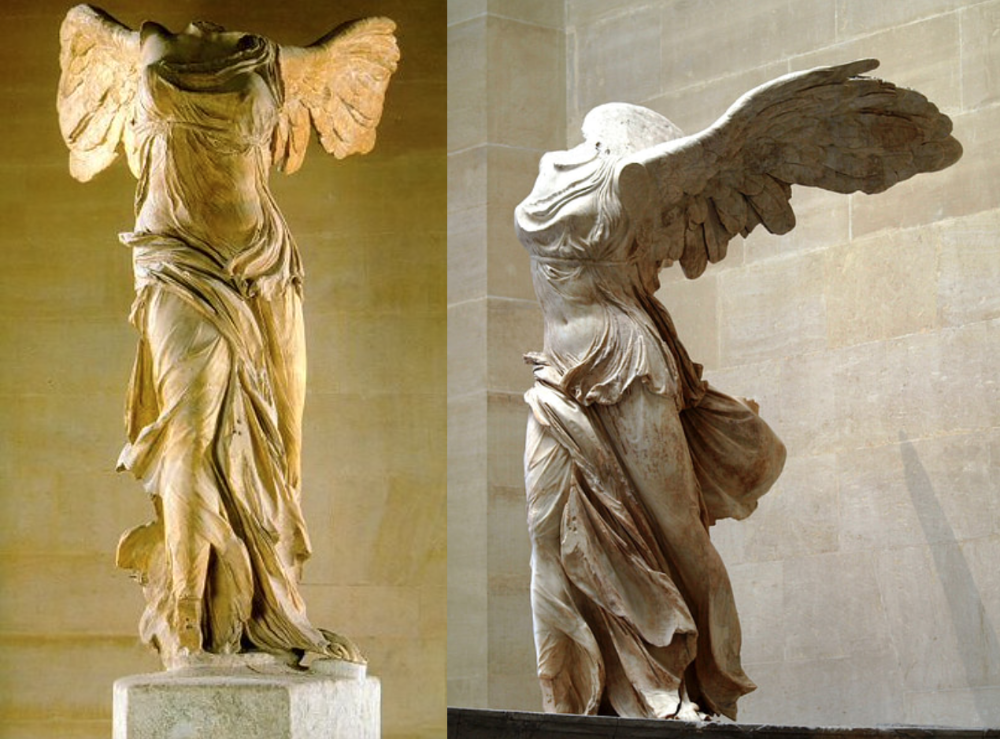
Nike alighting on a warship (Nike of Samothrace), c. 190 BCE. Marble and paint. Greek Hellenistic.
Very dramatic. Originally placed in the Sanctuary of the Great Gods. Often compared to Altar of Zeus. Drape is whipped by the wind, would have been facing the coast. Tension between upper and lower half. Lower half has a downward thrust like she's landing and the upper half is lifted up like she's still in the air. Torso twists. Sense of naturalism, wings look real. A public victory monument. Associated with the city state, Rhodes. Rhodes had fought Pergamon, paid for by the government. Baroque: theatrical, exaggerated, emotional.
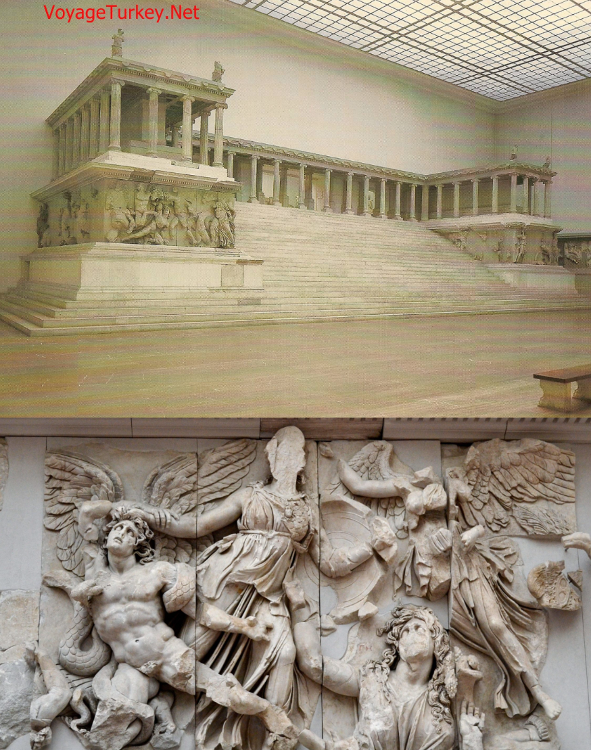
Altar of Zeus at Pergamon, with relief of Athena fighting a giant from the Battle of Gods and Giants. c. 174 BCE. Marble and paint. Greek Hellenistic.
Located in the Acropolis of Pergamon (Turkey). Pergamon wasn't a democracy. Altar is an alternative shape (U-shape). Dramatic staircase and lead-up to the top. Doesn't have a pediment. Figures convey a lot of emotion. Drapery is very dramatic and deeply carved. Figures don't have balanced poses. Depicts the battle of the Gods and Giants, the Gods win. Symbolically represents the Greek's victory against nature and barbarians. Located in Berlin because, Germany was creating an Empire, believed that to be a Great Empire, you needed Greek Art.
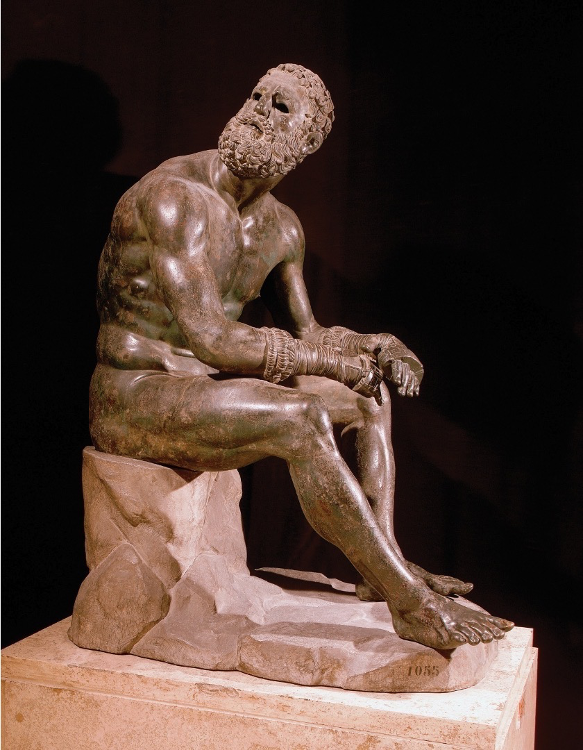
Seated Boxer, c. 100-50 BCE. Rome, Italy. Bronze with copper and crystal. Hellenistic/Roman.
Face of figure contains a lot of emotion, looks defeated. Copper on the face and back to depict scars and blood. Wore metal-studded boxing gloves back then. Boxing was a potential path out of slavery but possibly at the cost of your life. From Rome, at this point there are no more Hellenistic kingdoms, they've all been conquered by the Persians and Romans, the Romans loved Greek Art.
Hellenistic Painting on Vases and Wall
" "
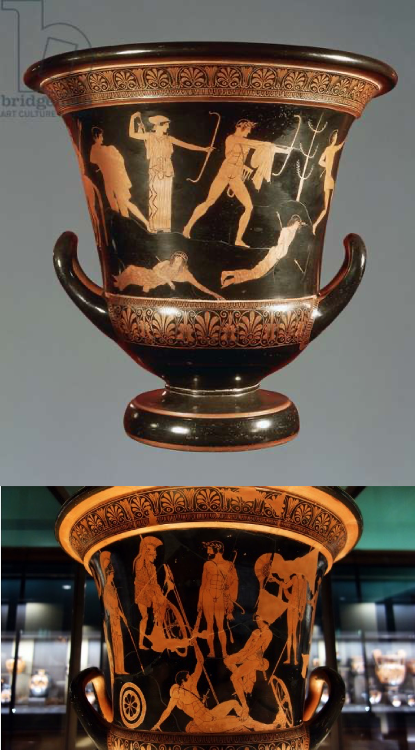
“Artemis and Apollo slaying the children of Niobe,” Niobid painter, c. 450 BCE. Clay and slip. Red Figure vase. Etruscan High Classical.
This vase was a mixing bowl for wine and water for a symposium, was found in Etruscan tombs. Back side: Niobe had 14 children, bragged that they were more beautiful than Leto's children, Apollo and Artemis. Both children exact revenge for their mother, they murder all 14 children. The figures have a stiffness, Goddess and God are in profile but the murdered children are not. Hubris: don't offend the Gods. Front side: Soldiers surrounding a statue of Hercules asking for his protection before battle. The figures are very relaxed, and in depth. The Sever style: in between Archaic and High classical.
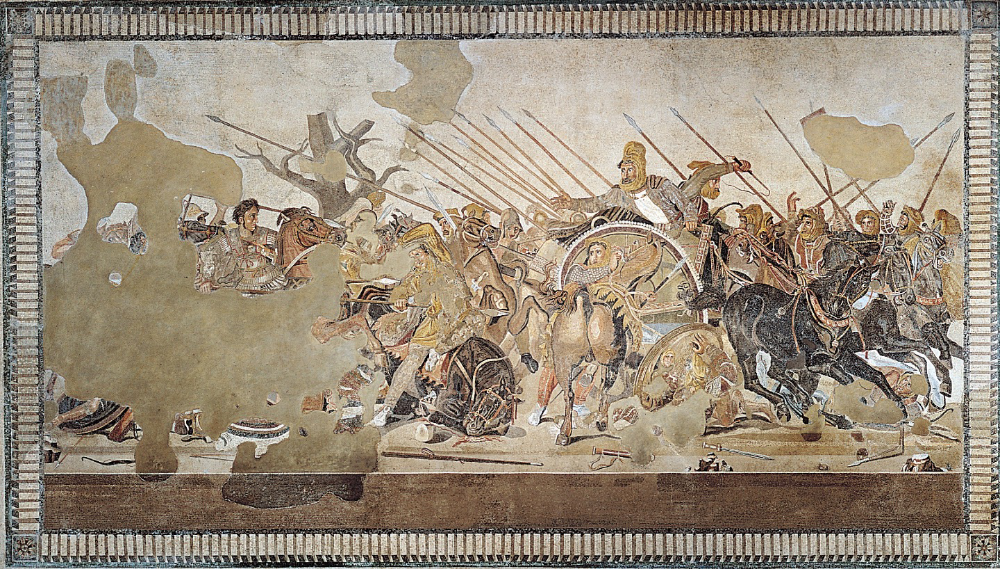
“Battle of Issus,” Philoxenos Eretria or Helen of Egypt. 310 BCE. Original painting in fresco; copy is a Roman pebble floor mosaic found in the House of the Faun, Pompeii, Italy from the late 1st Century BCE or early 1st Century CE. Greek/Roman Hellenistic.
Hellenistic: much more depth, many more figures. Depicts the Great ruler of Persia turning and fleeing from Alexander the Great. Darius is scared in the face of Alexander. Darius' face conveys surprise, worry, and seeking compassion. Incredible naturalism. Ancient Greek knowledge of anatomy is clear in this artwork. This is a Roman copy in the ground of a Greek wall painting. It was preserved under the ash in Pompeii. Rich Roman people made copies of Greek art because they saw themselves as natural descendants of Alexander the Great, as the people who would extend and solidify his achievements. Saw themselves as the natural successors of the Greeks.
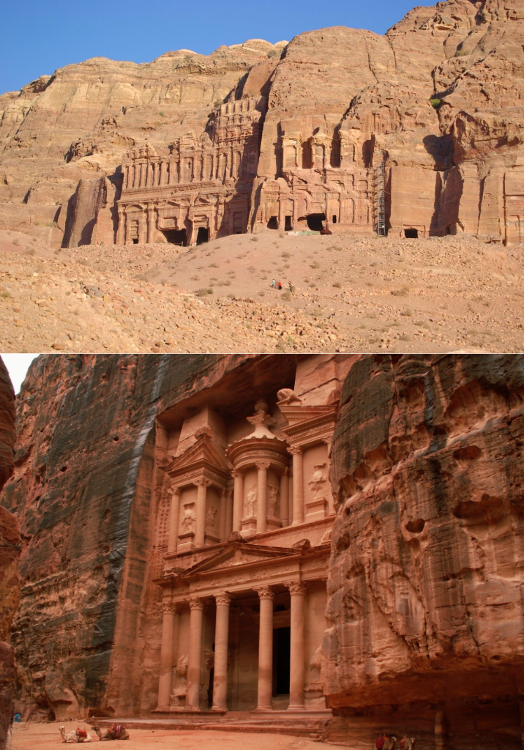
Petra, Jordan: Treasury and Great Temple. Nabataean Ptolemaic and Roman. c. 400 B.C.E.–100 C.E. Cut rock. High Classical/Hellenistic.
...